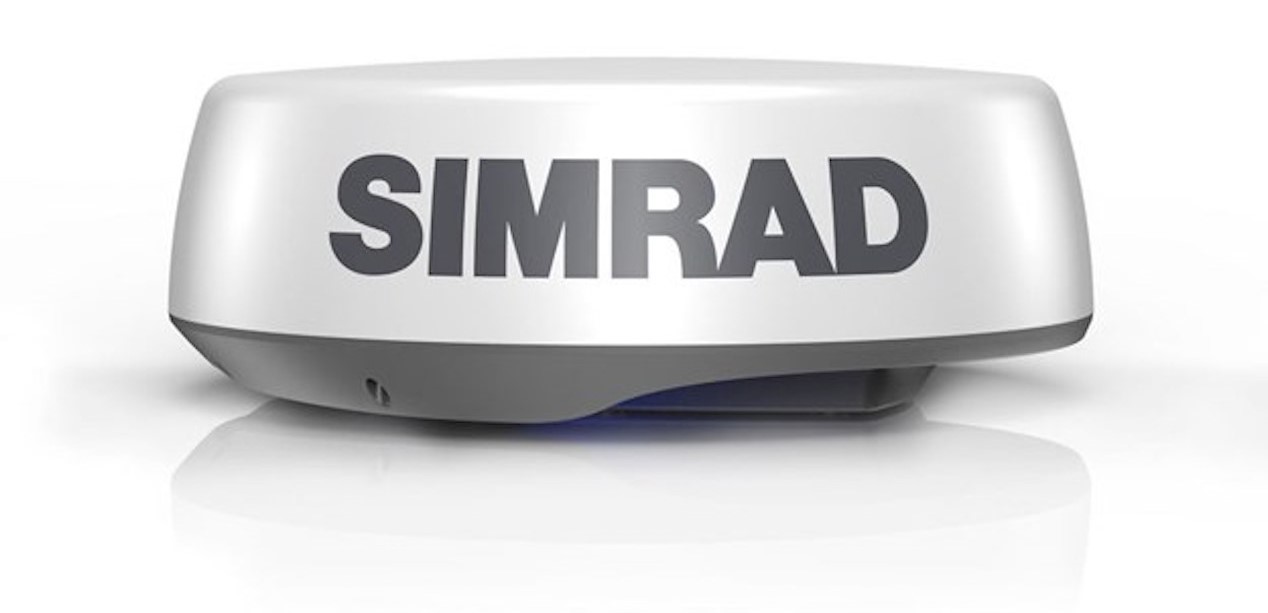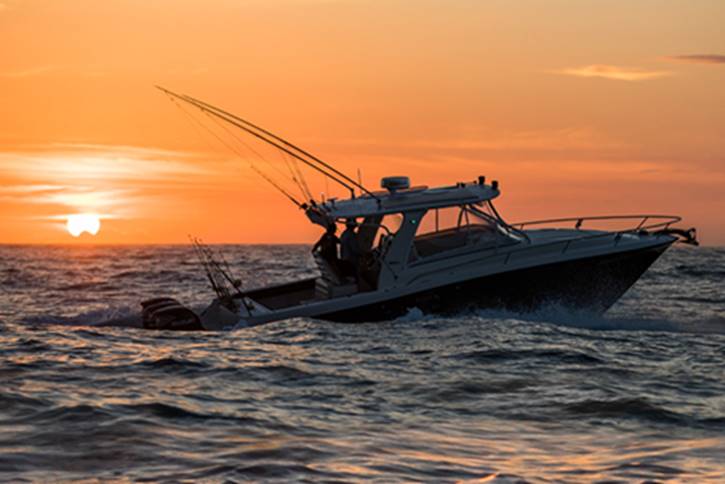SIMRAD HALO24 Radar
SIMRAD HALO24 Radar
Feature Packed Unit in an Affordable Price

Captain’s Report by Capt. Steve
Overview
SIMRAD’s HALO24 is a powerhouse radar unit with an unprecedented 60-RPM sweep for the most real-time tracking available, doppler technology and long-range coverage up to 48 miles.
Now, let’s be clear on the simple fact that just because this unit arrives at your front door, that does not mean you can go to your boat and have a working radar to show off. You still need to display the radar imagery and that means connecting it to an existing SIMRAD MFD (Multi-Function Display) with an ethernet connection.
Let’s cut through the hype first.
First things first… when the marketing team gets ahold of a line like “coverage up to 48 miles” it does not mean that we can see our buddy’s boat that far away. Not going to happen. The antenna needs to be really high and the boat we’re seeing would need to be really big… like a container ship. And even then, it’s questionable. So, what do we care about with a 48 mile radar then?

In a word, weather. Tracking a thunderstorm, or a cell, or a squall… etc. becomes an invaluable tool when offshore, and the farther away you can see it the more notice you have of its track and approach. It’s also nice to see if it’s building, by the darkening colors, or dispersing. Yes, there are also those that will say “I can see landfall from that far away,” but so what… a GPS is a better tool for that. For my money, I’ll take a long-range radar for tracking weather over the horizon any day, and twice on Sunday’s.
Of course, for traffic avoidance, the close-range features are the tools of choice. This unit not only allows for scanning up to 48nm away, but for as close as 100 meters (328’) with 18 range setting between the two end points. Units are also user-defined for NM, SM and KM.
About those RPM’s
Ok, this is big. With that big 24” (60.96 cm) antenna sweeping a full circle every second, we’re getting an image displayed on our screens that is very nearly real time. But this is when viewing within a 1.5nm range. Outside of that the signal simply needs more time to make it out to the target and back to the receiver. But when navigating a harbor with busy commercial traffic in heavy fog, it’s a game changer.

Let’s go over some cool features
Dual Range – This allows for having two radar images, side-by-side on the same screen. Set one for near and one for longer range. With the HALO24 we can even use different modes for each side, such as inshore for one and weather for the other.
Radar overlay on a chart – Use this feature to show returns projected onto a chart. Now we can see that the target showing over the buoy on the chart is indeed a buoy and not a stationary boat.
Directional Clutter Rejection – Every radar has sea clutter and rain clutter adjustments. DCR works in “Harbor” or “Offshore” modes to allow smaller vessels to be seen in the leeward direction of the sea clutter. This is accomplished by the radar receiver automatically increasing the gain dynamically during the sweep in the leeward direction for increased target sensitivity in heavier sea states.
Look Ahead – Much like the look ahead feature in the “Chart” mode, this brings the center of the display, where our boat is (PPI or Plan Position Indicator), down to the lower third of the display. This allows for giving a view that is more dedicated to the area ahead of the boat rather than behind. This is beneficial, for example, when underway at 30 knots. We really only care about seeing what is ahead and to the sides, and not really with what is miles behind. We still have a view behind but only up close, so an overtaking vessel is not a pop-up surprise. There’s also an “Offset” mode to move the PPI to a location defined by the cursor.

VelocityTrack – With Doppler technology we get to see movement of targets at a much better interpretation level by color coding which ones are approaching or diverging. This happens when two things are true… 1) The target’s relative speed is greater than the VelocityTrack speed threshold and 2) the target is not geo-stationary (land, buoy, daymark…etc.). Because different color palettes are available in the user menu, the colors of the approaching targets can vary between yellow and red but diverging targets will always be blue.
CHIRP Technology for Radar
Pulse Compression Technology – This is a bit more complicated, but it works like this. Short pulses of the radar give better resolution and long pulses can leave large blind zones. HALO transmits 6 different pulses with each sweep of the antenna. One is a continuous wave (CW) and the other five are CHIRP pulses, where the signal varies over time.
The CW is used for the short ranges while the CHIRP gives better returns over various farther ranges at the same time. The return from the shorter pulses fills in the blind zones of the longer returns and the returns are then “stitched” together on the display as a single image. This allows for better resolution of a target’s heading and range which makes it easier to track the target.
Pricing
The MSRP for the SIMRAD HALO24 is $3099
Observations
This is just a sampling of the many features that the HALO24 is capable of. The full operations manual is included in the MFD (Multi-Function Display) manual that the radar connects to and should be referenced.
Intuitive Operation is a Must. I’ve said time and again that one of the biggest features with SIMRAD products is the simplistic user interface. This is another example of that and getting your hands on the product will be convincing that a manual is just a secondary concern… if even a concern at all. Everything about this radar is intuitive, and the most used functions… sea clutter, rain clutter, modes and orientation, are all right on the main screen and need no menu trails to navigate to.
With so much to offer, the HALO24 brings features that were previously only available to larger yachts, and of course with compression technology… the military, to smaller recreational vessels at an affordable price. Gone are the days when having a capable radar on a smaller boat just wasn’t a viable alternative. Remember in the 60’s and 70’s when radar would cost as much as the boat… well those days are gone as well.
Specifications:
Environmental
- Operating Temperature -25° to +55° C (-13° to +130° F)
- Relative humidity +35° C (95° F), 95% RH
- Waterproof IPX6
- Max relative wind velocity 51 m/sec (100 Knots)
- Compliance CE, FCC (ID:RAY3G4G), IC: 4697A-3G4G, IEC60945 : 2002
Power & Dimensions
- Power consumption (with 10m cable) Operating: 14.5 to 27W at 13.8 V
- Standby 3.9 W (Typ.) at 13.8 V DC ~ 170 mA
- DC input (at end of radar cable) 9 V to 31.2 V DC (12/24 V systems)
- Reverse polarity protection Yes
- Minimum startup voltage 10.75 V DC
- Transmitter source (pre-heating time) No magnetron Instant On
Physical
- Outside dimensions: Diameter 610 mm (24"), Height 225 mm (8.9")
- Scanner weight (no cable): 6.75kg (14.9 lbs)
Radar and Antenna parameters
- Radar ranges 100 m (328 ft) to 48nm with 18 range settings, (nm/sm/km)
- Rotation (mode dependent) 20 - 60 rpm (mode and MFD dependent)
- Transmitter frequency X-band - 9.4 to 9.5 Ghz
- Transmitter source (warm-up time) No Magnetron all solid state. Instant On™
- Plane of polarization Horizontal Polarization
- Transmitter peak power output 25W
- Minimum range 6 m (19.7 ft)
- Sweep repetition frequency 700-2400 Hz (mode dependent)
- Pulse length 0.04 - 64 use
- Sweep bandwidth 48 MHz max
- Horizontal beam width (Tx and Rx antenna) 3.9° nominal (-3 dB width)
- Target Separation Control OFF: 3.9° ±10% (-3 dB width nominal), LOW: ~3.4° ± 10% (-3 dB width nominal), MED: ~2.5° ± 10% (-3 dB width nominal), HIGH: ~2.0°± 10% (-3 dB width nominal)
- Vertical beam width (Tx and Rx antenna) 22° (-3B width nominal)
- Side lobe level (Tx and Rx antenna) Below -18 dB (within ±10°) Below -24 dB (outside ±10° )
- Noise figure Less than 5 dB nominal
Communications/Cabling
- Protocol Ethernet 100 Base T
- Maximum inter connecting cable length 30 m (98.5 ft) available as option, use NEP-2 for longer cable runs